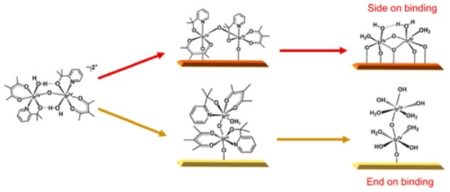Aug
8
A Major Step To a Good Low Cost Water Splitting Catalyst
August 8, 2018 | Leave a Comment
The American Chemical Society is reporting, with open access, in ACS Central Science a new catalyst that is really the best of both worlds. Taking water and ripping it apart into hydrogen and oxygen could form the basis of artificial photosynthetic devices that could ultimately power homes and businesses.
However, catalysts, including those used to ‘split’ water, have either worked well but are expensive and unstable, or are affordable and stable, but don’t work as well.
Identifying ideal materials that can split water is a long-standing problem in renewable energy storage. Catalysts, which help reactions occur, are often used in this process.

The synthesis strategy for side-on and end-on bound DHCs. The binding mode is defined by the structure of the substrate. When dual binding sites with the suitable density and distance are available (such as on Fe2O3, panel A), a side-on mode is preferred. Otherwise, the end-on mode is preferred (such as on WO3, panel B). Image Credit: ACS Central Science. Click image for the largest view. Use the study paper link above for complete details.
“Homogeneous” ones dissolve into the reaction solution and are usually active and selective. However, they don’t work well in some applications because they are unstable and expensive. In contrast, “heterogeneous” catalysts are solids that are stable, recyclable and convenient to work with, but they are usually not very active or selective.
The researchers developed a new hybrid catalyst made of iridium dinuclear heterogeneous catalysts (DHCs) attached to a tungsten oxide substrate. They found that attaching the ends of the DHC molecules – instead of the sides – allowed the catalyst to perform optimally. The researchers suggest that this first-of-its-kind material could be an important step toward alternative solar energy storage or artificial photosynthesis.
The journal paper is open access and while technical is good at explaining what goes on. This development is quite an improvement in a field fraught with ideas that just don’t work out. This work is a strong step into how a forever fueled world might work.
Its interesting no claim of total success is made, rather the insights gained are in full view. This is an honorable team worthy of respect and some admiration. They may be further along than they allow, replication will surely take this further. This is science at its best.

